Spatial and Temporal Variability of Rainfall Erosivity in the Niyang River Basin
Abstract
:1. Introduction
2. Materials and Methods
2.1. Study Area
2.2. Data Source
2.3. Calculation Model of Rainfall Erosivity
2.4. Spatial Statistical Analysis
2.5. Correlation Analysis
3. Results
3.1. Calculation of Rainfall Erosivity
3.2. Temporal Analysis of Rainfall Erosivity
3.3. Spatial Analysis of Rainfall Erosivity
3.3.1. Spatial Variability of Average Annual Rainfall Erosivity
3.3.2. Interannual Variation in Rainfall Erosivity
3.3.3. Intra-Annual Spatial Distribution of Rainfall Erosivity
3.3.4. Seasonal Distribution of Rainfall Erosivity
3.4. Correlation Analysis of Factors Affecting Rainfall Erosivity
4. Discussion
5. Conclusions
Author Contributions
Funding
Institutional Review Board Statement
Informed Consent Statement
Data Availability Statement
Acknowledgments
Conflicts of Interest
References
- Sun, W.; Shao, Q.; Liu, J. Soil erosion and its response to the changes of precipitation and vegetation cover on the Loess Plateau. J. Geogr. Sci. 2013, 23, 1091–1106. [Google Scholar] [CrossRef]
- Wuepper, D.; Borrelli, P.; Finger, R. Countries and the global rate of soil erosion. Nat. Sustain. 2020, 3, 51–55. [Google Scholar] [CrossRef]
- Owens, P.N. Soil erosion and sediment dynamics in the Anthropocene: A review of human impacts during a period of rapid global environmental change. J. Soils Sediments 2020, 20, 4115–4143. [Google Scholar] [CrossRef]
- Panagos, P.; Borrelli, P.; Poesen, J.; Ballabio, C.; Lugato, E.; Meusburger, K.; Montanarella, L.; Alewell, C. The new assessment of soil loss by water erosion in Europe. Environ. Sci. Policy 2015, 54, 438–447. [Google Scholar] [CrossRef]
- Tsitsagi, M.; Berdzenishvili, A.; Gugeshashvili, M. Spatial and temporal variations of rainfall-runoff erosivity (R) factor in Kakheti, Georgia. Ann. Agrar. Sci. 2018, 16, 226–235. [Google Scholar] [CrossRef]
- Jian, Z.; Rong, L.I. Soil Erosion and Subarea Characteristics in Yarlung Tsangpo River Basin. J. Yangtze River Sci. Res. Inst. 2008, 25, 42–45. [Google Scholar]
- Chen, Y.; Xu, M.; Wang, Z.; Gao, P.; Lai, C. Applicability of two satellite-based precipitation products for assessing rainfall erosivity in China. Sci. Total Environ. 2021, 757, 143975. [Google Scholar] [CrossRef]
- Lukić, T.; Micić Ponjiger, T.; Basarin, B.; Sakulski, D.; Gavrilov, M.; Marković, S.; Zorn, M.; Komac, B.; Milanović, M.; Pavić, D.; et al. Application of Angot precipitation index in the assessment of rainfall erosivity: Vojvodina Region case study (North Serbia). Acta Geogr. Slov. 2021, 61, 123–153. [Google Scholar] [CrossRef]
- Boardman, J. Communicating soil erosion in the UK: How should we present extreme events? Geogr. J. 2023, 190, e12554. [Google Scholar] [CrossRef]
- Lai, C.; Chen, X.; Wang, Z.; Wu, X.; Zhao, S.; Wu, X.; Bai, W. Spatio-temporal variation in rainfall erosivity during 1960–2012 in the Pearl River Basin, China. Catena 2016, 137, 382–391. [Google Scholar] [CrossRef]
- Cook, H.L. The Nature and Controlling Variables of the Water Erosion Process. Soil Sci. Soc. Am. J. 1937, 1, 487–494. [Google Scholar] [CrossRef]
- Wischmeier, W.H. Predicting rainfall erosion losses-a guide to conservation planning. In Agriculture Handbook; U.S. Department of Agriculture: Washington, DC, USA, 1978; p. 537. [Google Scholar]
- Liang, X.; Zhang, L.; He, S.; Song, K.; Zheng, Z. Characteristics and Projection of Rainfall Erosivity Distribution in the Hengduan Mountains. Land 2023, 12, 1435. [Google Scholar] [CrossRef]
- Sakhraoui, F.; Hasbaia, M. Evaluation of the sensitivity of the RUSLE erosion model to rainfall erosivity: A case study of the Ksob watershed in central Algeria. Water Supply 2023, 23, 3262–3284. [Google Scholar] [CrossRef]
- Fenta, A.A.; Tsunekawa, A.; Haregeweyn, N.; Yasuda, H.; Tsubo, M.; Borrelli, P.; Kawai, T.; Sewale Belay, A.; Ebabu, K.; Liyew Berihun, M.; et al. Improving satellite-based global rainfall erosivity estimates through merging with gauge data. J. Hydrol. 2023, 620, 129555. [Google Scholar] [CrossRef]
- Panagos, P.; Borrelli, P.; Matthews, F.; Liakos, L.; Bezak, N.; Diodato, N.; Ballabio, C. Global rainfall erosivity projections for 2050 and 2070. J. Hydrol. 2022, 610, 127865. [Google Scholar] [CrossRef]
- Panagos, P.; Hengl, T.; Wheeler, I.; Marcinkowski, P.; Rukeza, M.B.; Yu, B.; Yang, J.E.; Miao, C.; Chattopadhyay, N.; Sadeghi, S.H.; et al. Global rainfall erosivity database (GloREDa) and monthly R-factor data at 1 km spatial resolution. Data Brief 2023, 50, 109482. [Google Scholar] [CrossRef]
- Wang, L.; Li, Y.; Gan, Y.; Zhao, L.; Qin, W.; Ding, L. Rainfall erosivity index for monitoring global soil erosion. Catena 2024, 234, 107593. [Google Scholar] [CrossRef]
- Padulano, R.; Santini, M.; Mancini, M.; Stojiljkovic, M.; Rianna, G. Monthly to seasonal rainfall erosivity over Italy: Current assessment by empirical model and future projections by EURO-CORDEX ensemble. Catena 2023, 223, 106943. [Google Scholar] [CrossRef]
- de Sousa Teixeira, D.B.; Cecilio, R.A.; Moreira, M.C.; Pires, G.F.; Fernandes Filho, E.I. Assessment, regionalization, and modeling rainfall erosivity over Brazil: Findings from a large national database. Sci. Total Environ. 2023, 891, 164557. [Google Scholar] [CrossRef]
- Johannsen, L.L.; Schmaltz, E.M.; Mitrovits, O.; Klik, A.; Smoliner, W.; Wang, S.; Strauss, P. An update of the spatial and temporal variability of rainfall erosivity (R-factor) for the main agricultural production zones of Austria. Catena 2022, 215, 106305. [Google Scholar] [CrossRef]
- Padulano, R.; Rianna, G.; Santini, M. Datasets and approaches for the estimation of rainfall erosivity over Italy: A comprehensive comparison study and a new method. J. Hydrol. Reg. Stud. 2021, 34, 100788. [Google Scholar] [CrossRef]
- Pidoto, R.; Bezak, N.; Müller-Thomy, H.; Shehu, B.; Callau-Beyer, A.C.; Zabret, K.; Haberlandt, U. Comparison of rainfall generators with regionalisation for the estimation of rainfall erosivity at ungauged sites. Earth Surf. Dyn. 2022, 10, 851–863. [Google Scholar] [CrossRef]
- da Silva, R.M.; Santos, C.A.G.; da Costa Silva, J.F.C.B.; Silva, A.M.; Brasil Neto, R.M. Spatial distribution and estimation of rainfall trends and erosivity in the Epitácio Pessoa reservoir catchment, Paraíba, Brazil. Nat. Hazards 2020, 102, 829–849. [Google Scholar] [CrossRef]
- Li, Y.; He, Y.; Zhang, Y.; Jia, L. Spatiotemporal evolutionary analysis of rainfall erosivity during 1901–2017 in Beijing, China. Environ. Sci. Pollut. Res. Int. 2022, 29, 2510–2522. [Google Scholar] [CrossRef]
- Wang, W.; Yin, S.; He, Z.; Chen, D.; Wang, H.; Klik, A. Projections of rainfall erosivity in climate change scenarios for mainland China. Catena 2023, 232, 107391. [Google Scholar] [CrossRef]
- Zhou, J.; Bao, Y.H.; He, X.B.; Wen, A.B.; Jiang, G.Y.; Long, Y.; Li, J.L. Risk analysis of rainfall erosion on upland adjacent to riparian zone of the Three Gorges Reservoir. Catena 2023, 232, 107458. [Google Scholar] [CrossRef]
- Jiang, G.; Lv, J.; He, X.; Bao, Y. Influence of reservoir impoundment on rainfall erosivity in the Three Gorges Reservoir region of China. Hydrol. Res. 2022, 53, 1357–1371. [Google Scholar] [CrossRef]
- Zhang, Y.; Zhang, Y.; Shi, F.; Li, M. Temporal and Spatial Variation of Rainfall Erosivity in Middle Reaches of Yellow River Based on Different Models. Bull. Soil Water Conserv. 2023, 43, 220–229+238. [Google Scholar] [CrossRef]
- Chen, Y.; Ding, M.; Zhang, G.; Duan, X.; Wang, C. The possible role of fused precipitation data in detection of the spatiotemporal pattern of rainfall erosivity over the Tibetan Plateau, China. Catena 2023, 228, 107114. [Google Scholar] [CrossRef]
- Chen, Y.; Duan, X.; Zhang, G.; Ding, M.; Lu, S. Rainfall erosivity estimation over the Tibetan plateau based on high spatial-temporal resolution rainfall records. Int. Soil Water Conserv. Res. 2022, 10, 422–432. [Google Scholar] [CrossRef]
- Zeng, W.; Ding, X.; Sun, W.; Mu, X. Improvement of satellite-based rainfall product CHIRPS in estimating rainfall erosivity on the Loess Plateau. Land Degrad. Dev. 2023, 34, 4517–4528. [Google Scholar] [CrossRef]
- Dai, W.; Zeng, Y.; Jing, T.; Wang, Z.; Zong, R.; Ni, L.; Fang, N. Estimation of rainfall erosivity on the Chinese Loess Plateau: A new combination of the ERA5 dataset and machine learning. J. Hydrol. 2023, 624, 129892. [Google Scholar] [CrossRef]
- Li, X.; Wang, X.; Gu, J.; Sun, C.; Zhao, H.; You, S. Temporal and Spatial Variation in Rainfall Erosivity in the Rolling Hilly Region of Northeast China. Agronomy 2023, 13, 2877. [Google Scholar] [CrossRef]
- Yin, B.; Xie, Y.; Liu, B.; Liu, B. Rainfall Erosivity Mapping for Tibetan Plateau Using High-Resolution Temporal and Spatial Precipitation Datasets for the Third Pole. Remote Sens. 2023, 15, 5267. [Google Scholar] [CrossRef]
- Lu, S.J.; Chen, Y.L.; Duan, X.W.; Yin, S.Q. Rainfall erosivity estimation models for the Tibetan Plateau. Catena 2023, 229, 107186. [Google Scholar] [CrossRef]
- Xiong, L.; Liu, C.; Chen, S.; Zha, X.; Ma, Q. Review of post-processing research for remote-sensing precipitation products. Adv. Water Sci. 2021, 32, 627–637. [Google Scholar] [CrossRef]
- Meng, X.; Zhang, X.; Yang, M.; Wang, H.; Chen, J.; Pan, Z.; Wu, Y. Application and Evaluation of the China Meteorological Assimilation Driving Datasets for the SWAT Model (CMADS) in Poorly Gauged Regions in Western China. Water 2019, 11, 2171. [Google Scholar] [CrossRef]
- Meng, X.; Wang, H.; Shi, C.; Wu, Y.; Ji, X. Establishment and Evaluation of the China Meteorological Assimilation Driving Datasets for the SWAT Model (CMADS). Water 2018, 10, 1555. [Google Scholar] [CrossRef]
- Meng, X.; Wang, H.; Chen, J.; Yang, M.; Pan, Z. High-resolution simulation and validation of soil moisture in the arid region of Northwest China. Sci. Rep. 2019, 9, 17227. [Google Scholar] [CrossRef]
- Zhang, L.; Meng, X.; Wang, H.; Yang, M.; Cai, S. Investigate the Applicability of CMADS and CFSR Reanalysis in Northeast China. Water 2020, 12, 996. [Google Scholar] [CrossRef]
- Meng, X.; Wang, H.; Wu, Y.; Long, A.; Wang, J.; Shi, C.; Ji, X. Investigating spatiotemporal changes of the land-surface processes in Xinjiang using high-resolution CLM3.5 and CLDAS: Soil temperature. Sci. Rep. 2017, 7, 13286. [Google Scholar] [CrossRef] [PubMed]
- Meng, X.; Wang, H.; Chen, J. Profound Impacts of the China Meteorological Assimilation Driving Datasets for the SWAT Model (CMADS). Water 2019, 11, 832. [Google Scholar] [CrossRef]
- Meng, X.; Wang, H. Significance of the China Meteorological Assimilation Driving Datasets for the SWAT Model (CMADS) of East Asia. Water 2017, 9, 765. [Google Scholar] [CrossRef]
- Renard, K.G.; Freimund, J.R. Using monthly precipitation data to estimate the R-factor in the revised USLE. J. Hydrol. 1994, 157, 287–306. [Google Scholar] [CrossRef]
- Brychta, J.; Podhrázská, J.; Šťastná, M. Review of methods of spatio-temporal evaluation of rainfall erosivity and their correct application. Catena 2022, 217, 106454. [Google Scholar] [CrossRef]
- Li, J. Hourly station-based precipitation characteristics over the Tibetan Plateau. Int. J. Climatol. 2018, 38, 1560–1570. [Google Scholar] [CrossRef]
- Zhang, W.; Fu, J. Rainfall erosivity estimation under different rainfall amounts. Resour. Sci. 2003, 25, 35–41. [Google Scholar]
- Cui, Y.; Pan, C.; Liu, C.; Luo, M.; Guo, Y. Spatiotemporal variation and tendency analysis on rainfall erosivity in the Loess Plateau of China. Hydrol. Res. 2020, 51, 1048–1062. [Google Scholar] [CrossRef]
- Cui, B.; Zhang, Y.; Liu, L.; Xu, Z.; Wang, Z.; Gu, C.; Wei, B.; Gong, D. Spatiotemporal Variation in Rainfall Erosivity and Correlation with the ENSO on the Tibetan Plateau since 1971. Int. J. Environ. Res. Public Health 2021, 18, 11054. [Google Scholar] [CrossRef] [PubMed]
- Achite, M.; Katipoğlu, O.M.; Javari, M.; Caloiero, T. Hybrid interpolation approach for estimating the spatial variation of annual precipitation in the Macta basin, Algeria. Theor. Appl. Climatol. 2023, 155, 1139–1166. [Google Scholar] [CrossRef]
- Gharnouki, I.; Aouissi, J.; Benabdallah, S.; Tramblay, Y. Assessing the variability of satellite and reanalysis rainfall products over a semiarid catchment in Tunisia. Acta Geophys. 2024, 72, 1257–1273. [Google Scholar] [CrossRef]
- Alifujiang, Y.; Abuduwaili, J.; Samat, A.; Feng, P.; Jiang, Y. Concentration and correlation analysis of hydro-meteorological factors in the northern sub-basin of Lake Issyk-Kul in Central Asia. Ecol. Indic. 2024, 158, 111465. [Google Scholar] [CrossRef]
- Liu, H.; Li, X.; Yao, Z. Rainfall Erosivity in Yarlung Zangbo River Basin during 1961–2015. J. Desert Res. 2019, 39, 166–176. [Google Scholar]
- Liang, Y.; Shen, R.; Shi, C.; Xing, Y.; Sun, S. Rainfall erosivity in China based on CLDAS fusion precipitation. Arid Land Geogr. 2022, 45, 1333–1346. [Google Scholar] [CrossRef]
- Tian, X.; Li, F.; He, X.; Wan, X.; Lü, X.; Fang, L.; Yu, Q. Study on Daily Erosive Rainfall Standard in the Poyang Lake Basin. J. Soil Water Conserv. 2021, 35, 185–189. [Google Scholar] [CrossRef]
- Brychta, J.; Janeček, M. Determination of erosion rainfall criteria based on natural rainfall measurement and its impact on spatial distribution of rainfall erosivity in the Czech Republic. Soil Water Res. 2019, 14, 153–162. [Google Scholar] [CrossRef]
- Zhang, M.; Ren, Q.; Wei, X.; Wang, J.; Yang, X.; Jiang, Z. Climate change, glacier melting and streamflow in the Niyang River Basin, Southeast Tibet, China. Ecohydrology 2011, 4, 288–298. [Google Scholar] [CrossRef]
- Wang, J.; Li, Y.; Wu, J. Precipitation anomalies over Qinghai-Tibet Plateau during Bay of Bengal Storm double-peak periods. Theor. Appl. Climatol. 2024, 155, 3133–3146. [Google Scholar] [CrossRef]
- Sun, H.; Su, F.; Huang, J.; Yao, T.; Luo, Y.; Chen, D. Contrasting precipitation gradient characteristics between westerlies and monsoon dominated upstream river basins in the Third Pole. Chin. Sci. Bull. 2020, 65, 91–104. [Google Scholar] [CrossRef]
- Miao, W.; Liu, S.; Zhu, Y.; Duan, S.; Han, F. Spatio-temporal differentiation and altitude dependence of temperature and precipitation in Meili Snow Mountains. Progress. Inquisitiones Mutat. Clim. 2022, 18, 328–342. [Google Scholar]
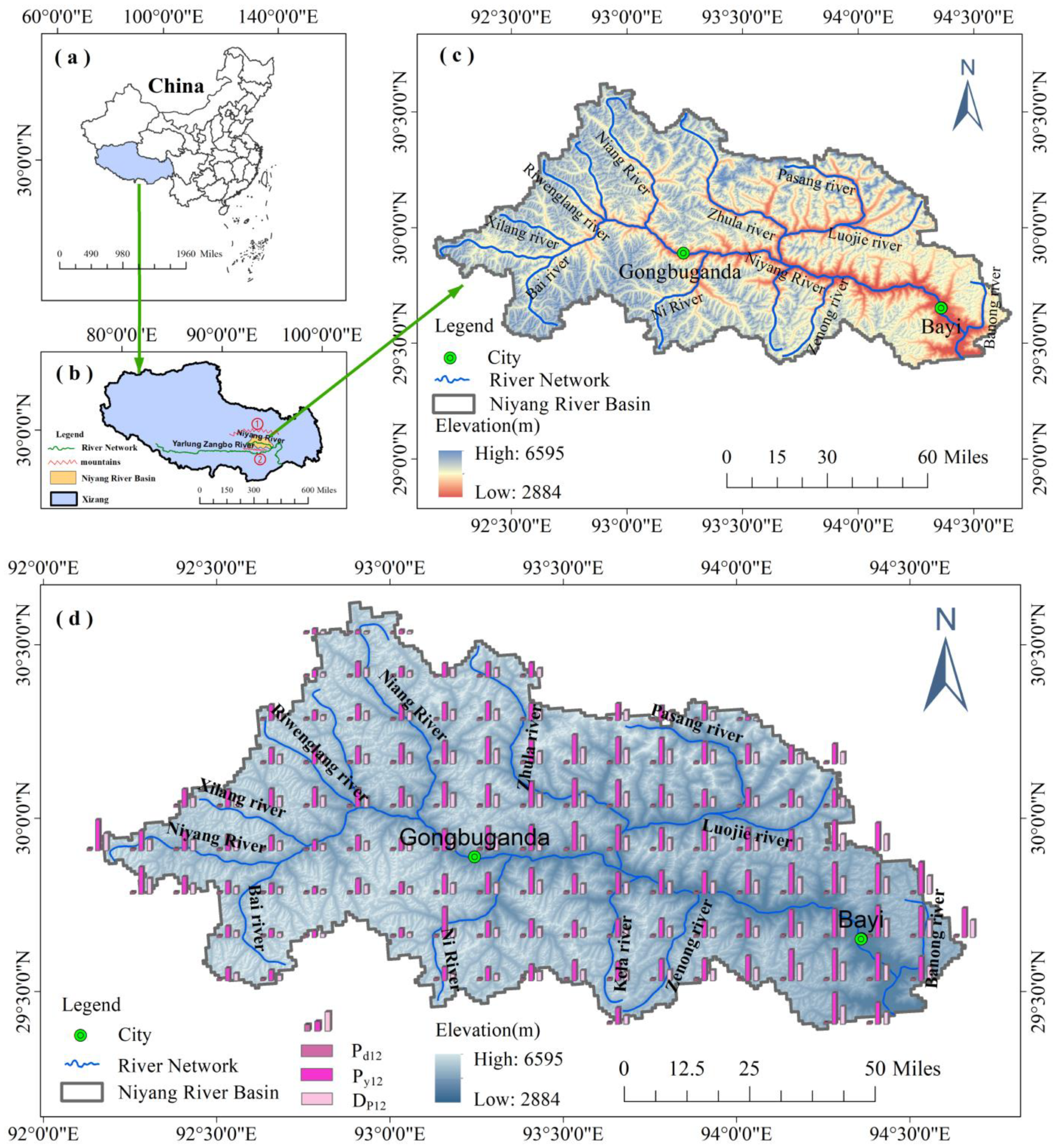
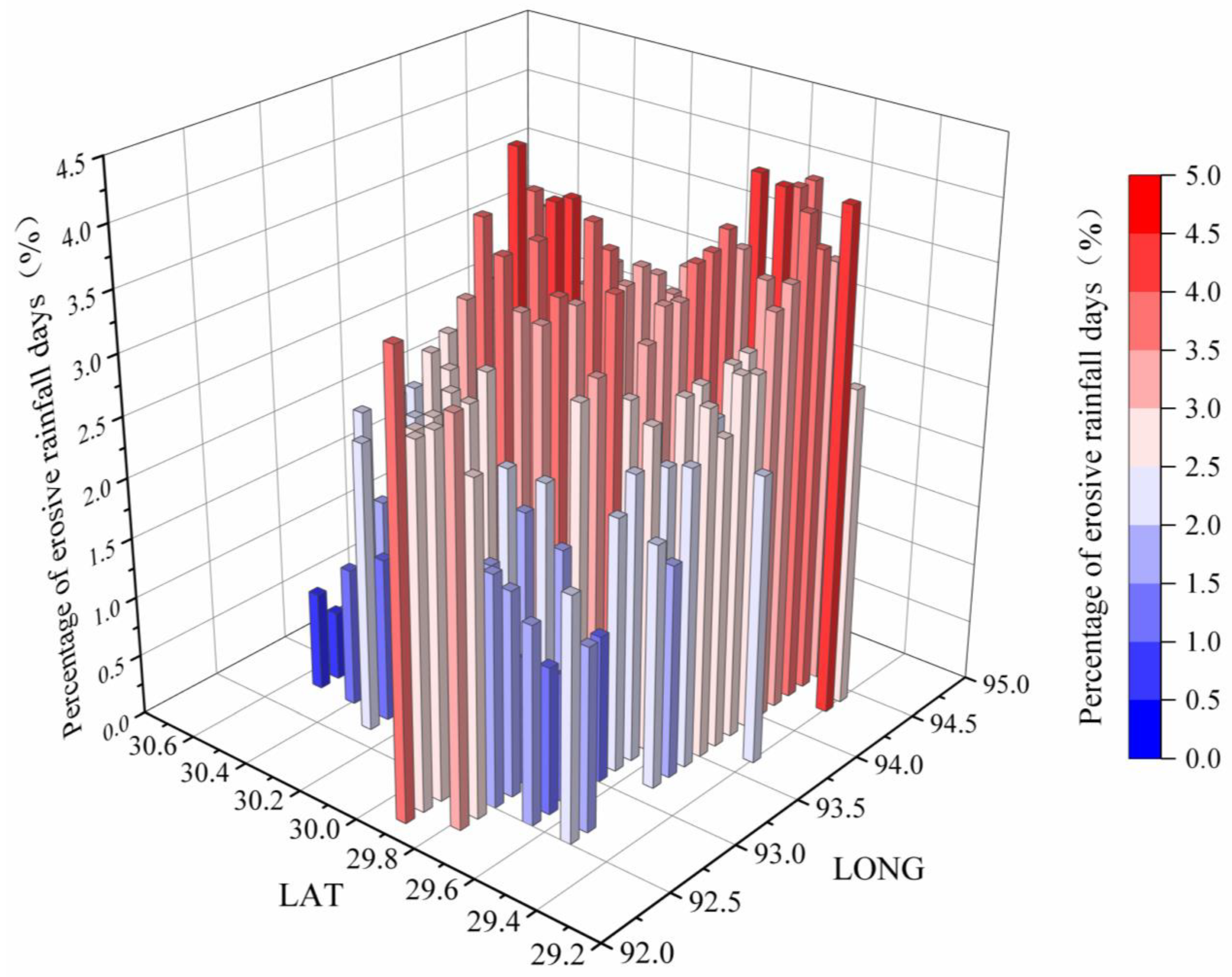

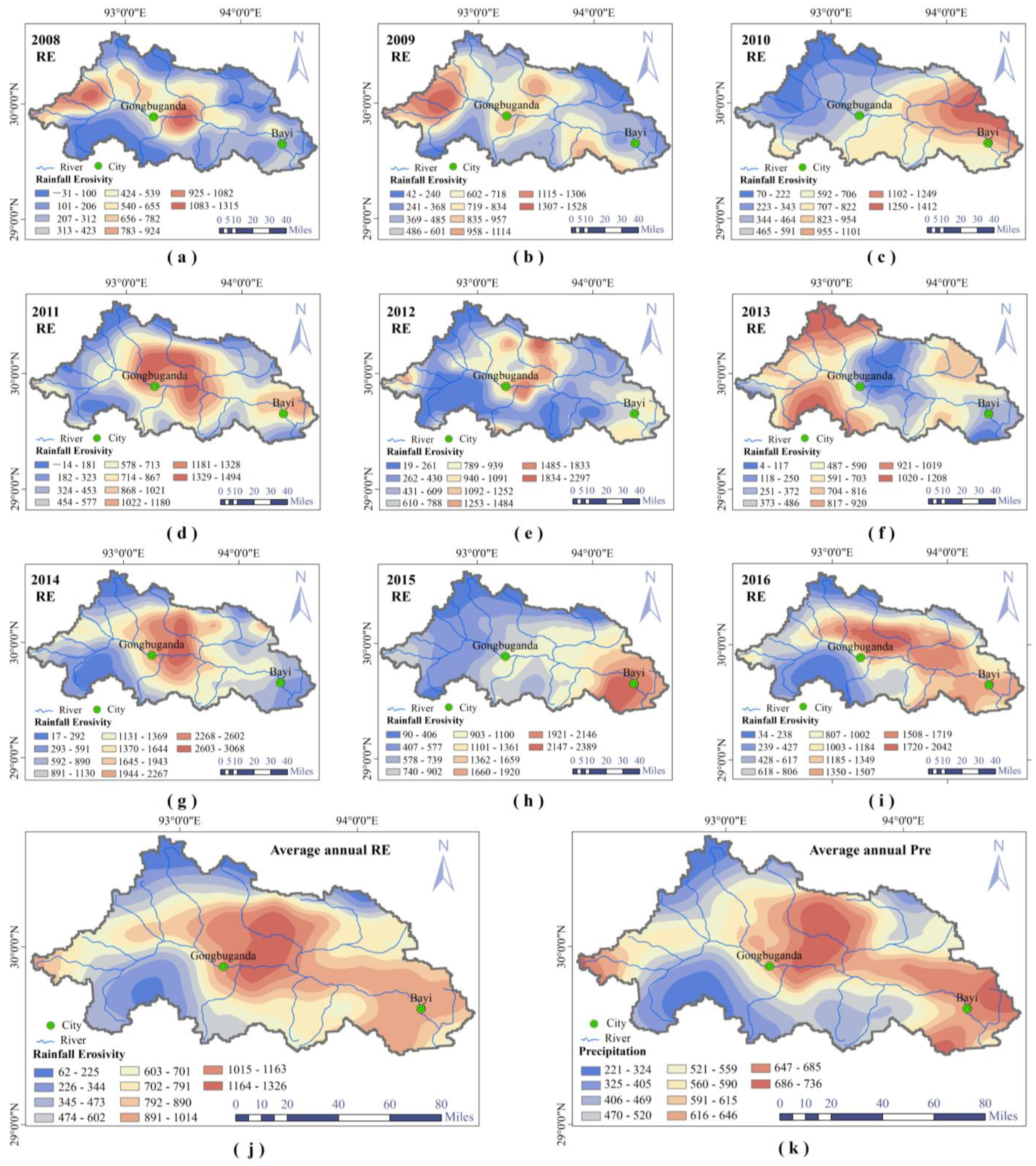
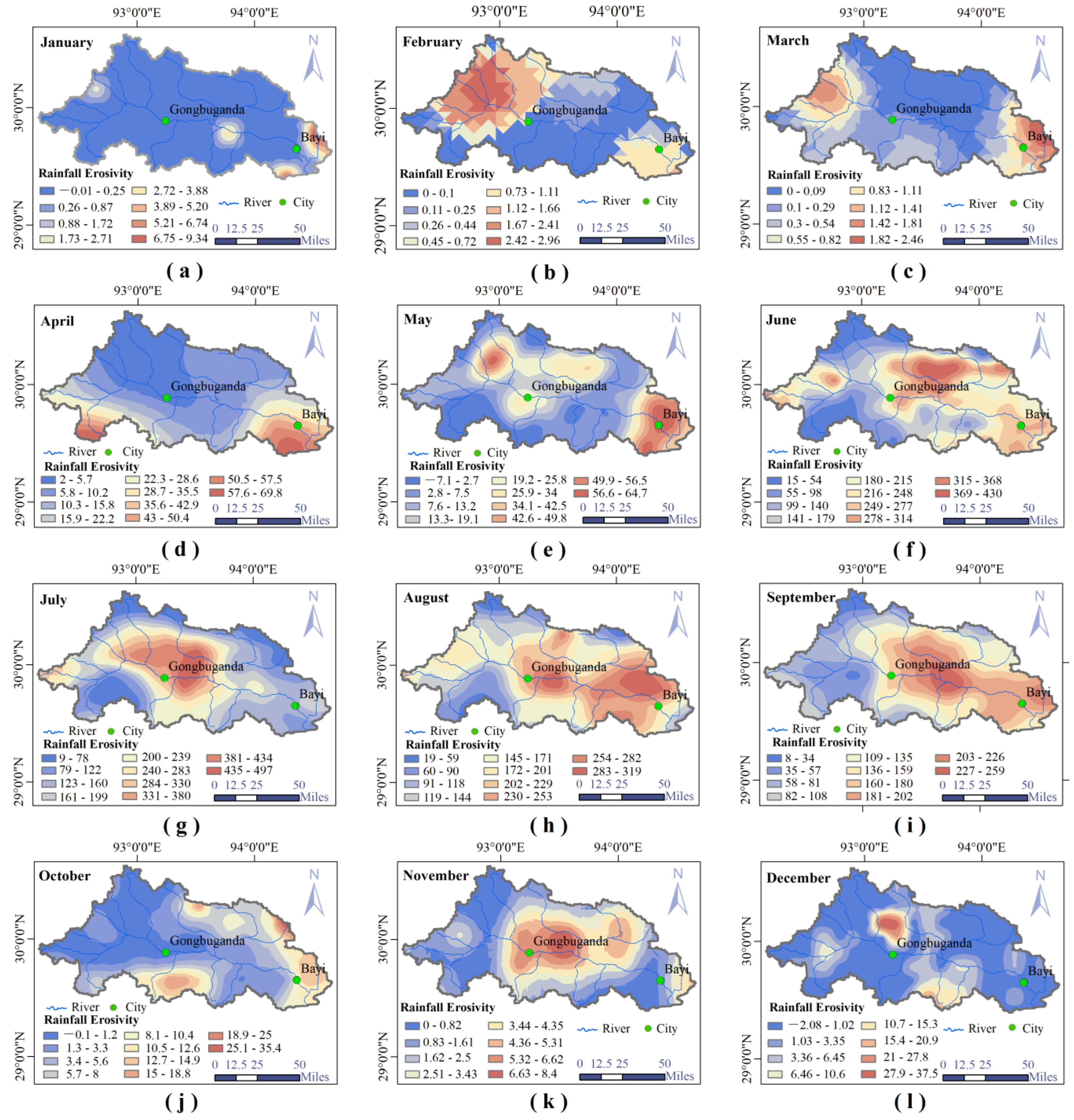
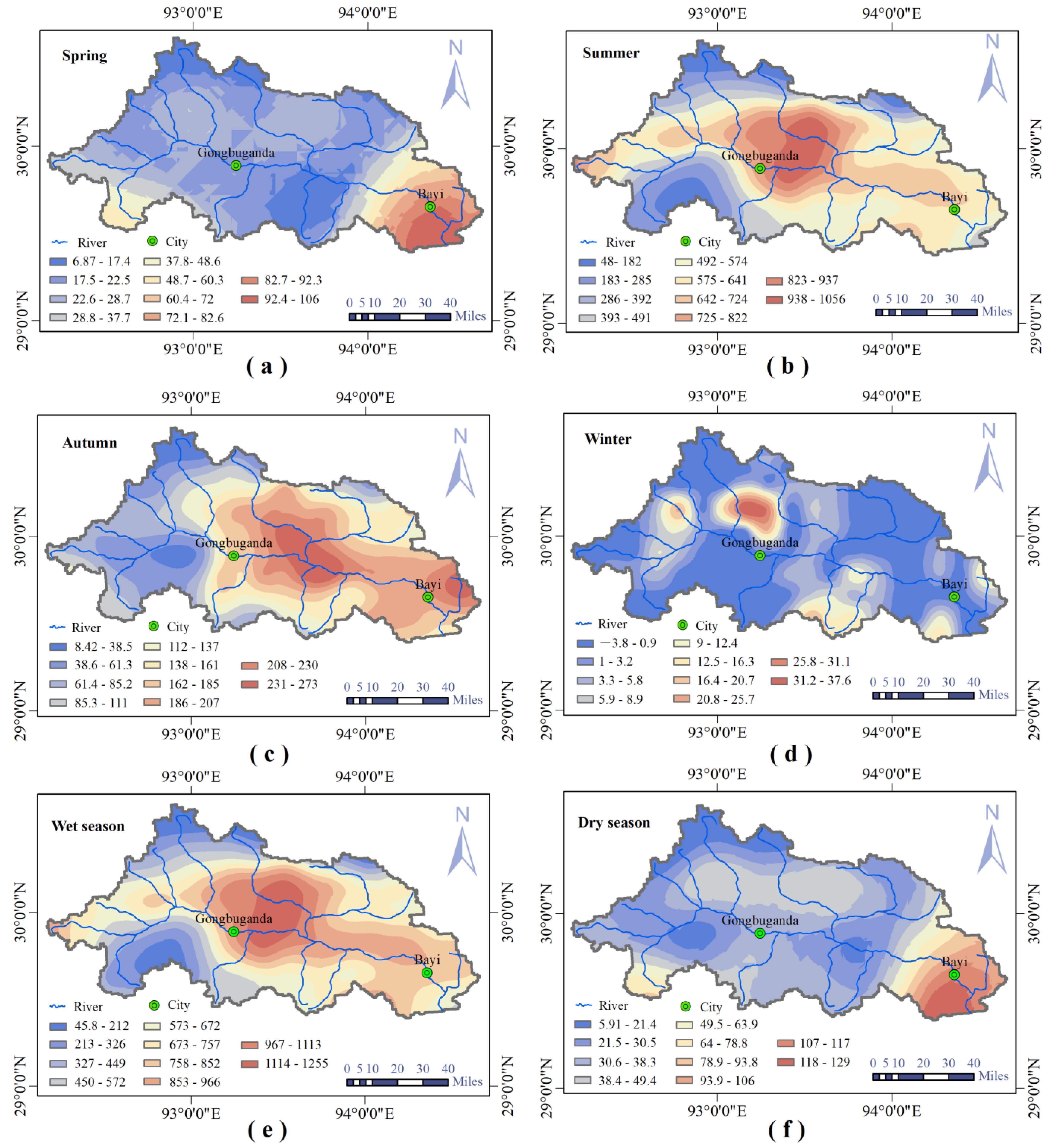

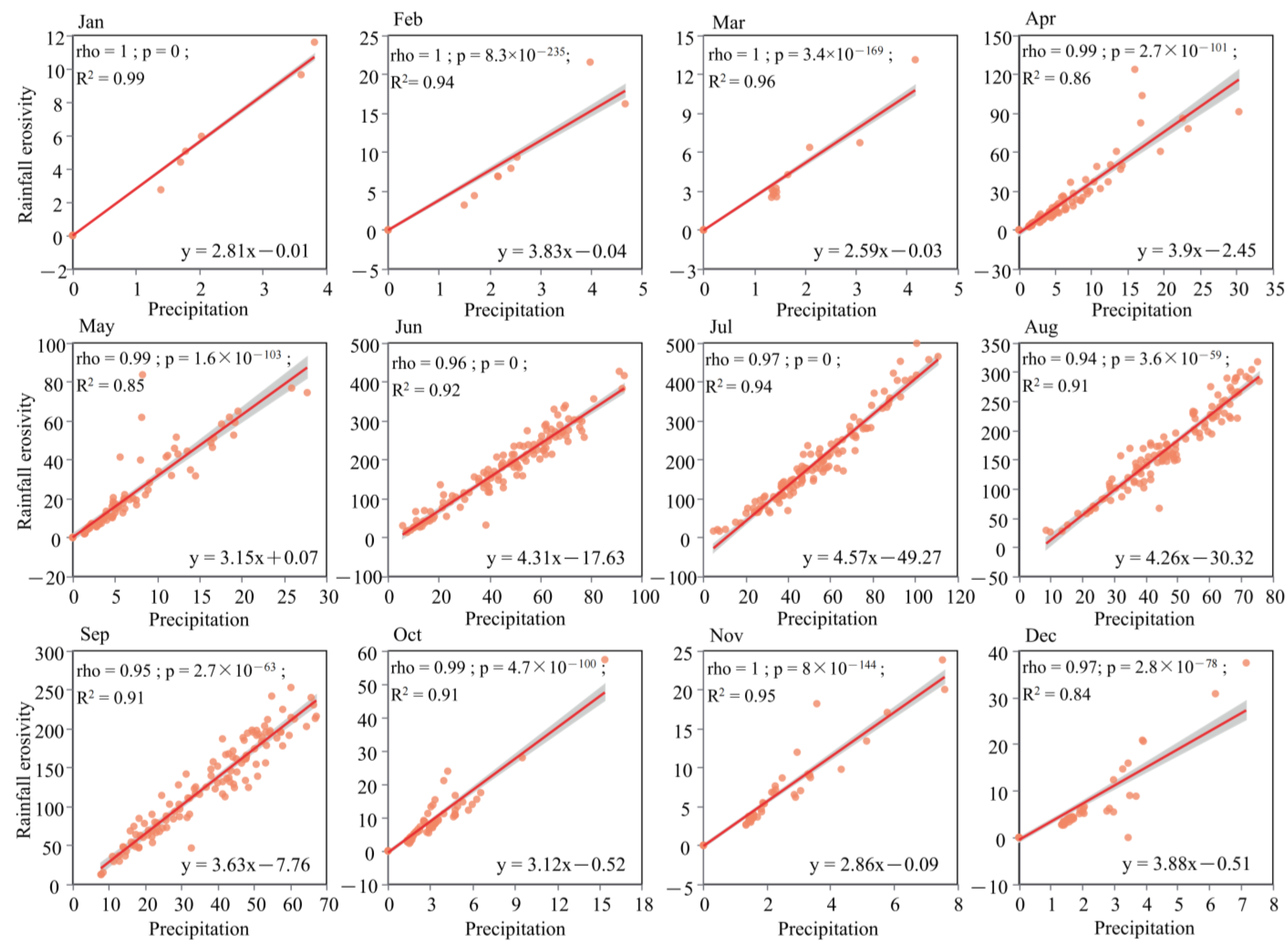
Disclaimer/Publisher’s Note: The statements, opinions and data contained in all publications are solely those of the individual author(s) and contributor(s) and not of MDPI and/or the editor(s). MDPI and/or the editor(s) disclaim responsibility for any injury to people or property resulting from any ideas, methods, instructions or products referred to in the content. |
© 2024 by the authors. Licensee MDPI, Basel, Switzerland. This article is an open access article distributed under the terms and conditions of the Creative Commons Attribution (CC BY) license (https://creativecommons.org/licenses/by/4.0/).
Share and Cite
Bai, Q.; Wang, L.; Cidan, Y. Spatial and Temporal Variability of Rainfall Erosivity in the Niyang River Basin. Atmosphere 2024, 15, 1032. https://doi.org/10.3390/atmos15091032
Bai Q, Wang L, Cidan Y. Spatial and Temporal Variability of Rainfall Erosivity in the Niyang River Basin. Atmosphere. 2024; 15(9):1032. https://doi.org/10.3390/atmos15091032
Chicago/Turabian StyleBai, Qingqin, Lei Wang, and Yangzong Cidan. 2024. "Spatial and Temporal Variability of Rainfall Erosivity in the Niyang River Basin" Atmosphere 15, no. 9: 1032. https://doi.org/10.3390/atmos15091032




